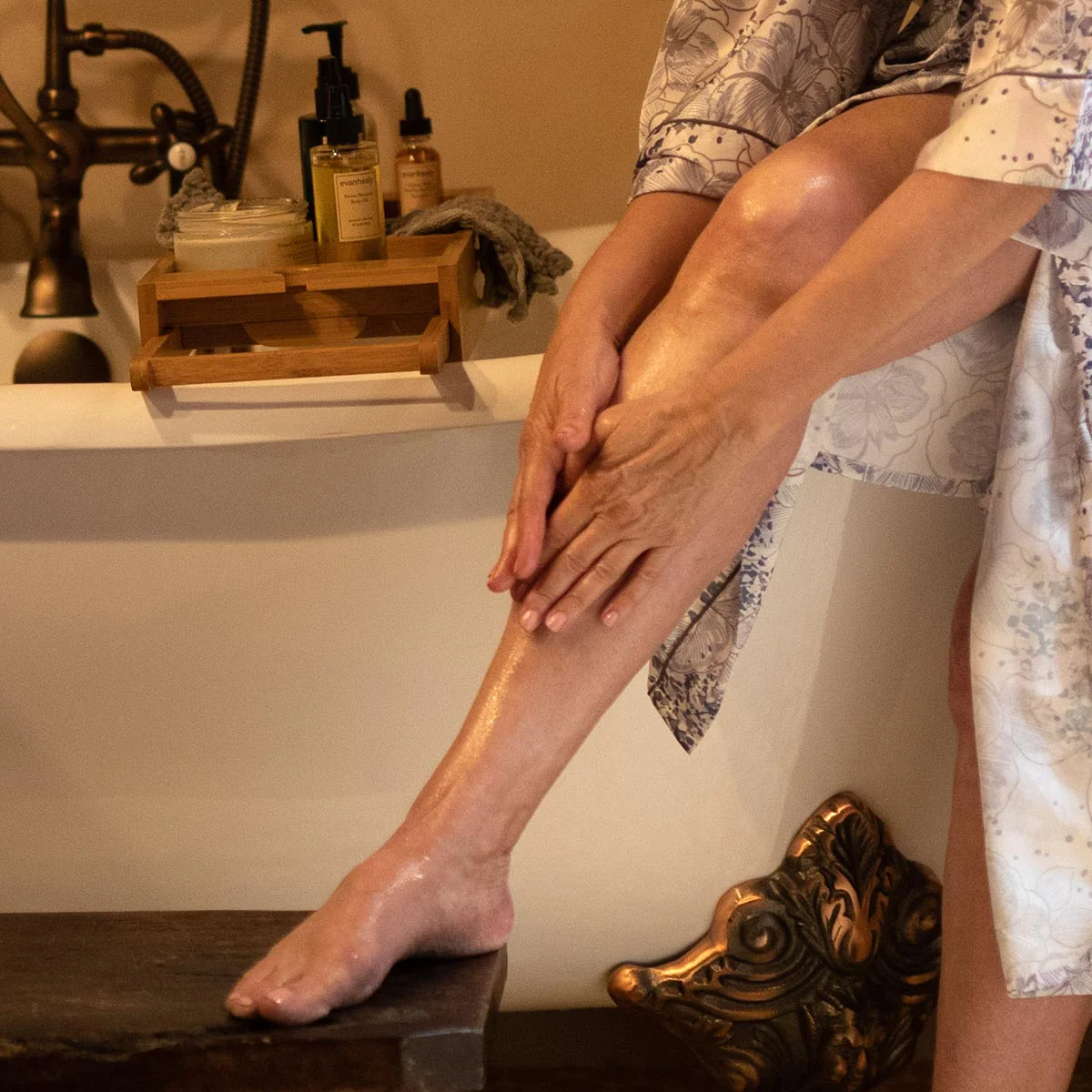
Glowing Guide: Mastering the Body Oil
The Art of Body Oil Application
Body oil offers a luxurious approach to skincare. It nourishes and hydrates the skin effectively. Users enjoy its smooth application and lasting effects. Body oil suits various skin types and concerns. This versatile product enhances overall skin health and appearance.
Understanding Body Oil Benefits
Body oil provides deep hydration to the skin. It locks in moisture for long-lasting effects. The oil creates a protective barrier against environmental stressors. Many formulas contain antioxidants for added skin benefits. Regular use can improve skin texture and elasticity.
Natural oils in these products mimic the skin’s sebum. This similarity allows for better absorption and effectiveness. Body oils often contain essential fatty acids. These nutrients support skin cell regeneration. The result is smoother, more radiant skin over time.
Aromatherapy benefits enhance the body oil experience. Many products feature natural fragrances. These scents can uplift mood and reduce stress. Lavender oils promote relaxation, while citrus scents energize. The olfactory experience adds value to the skincare routine.
Choosing the Right Body Oil
Selecting the appropriate body oil requires consideration of skin type. Dry skin benefits from richer oils like avocado or coconut. Oily skin types should opt for lighter formulas such as grapeseed or jojoba. Combination skin can use blended oils for balanced hydration.
Consider the oil’s intended purpose when making a selection. Some oils focus on anti-aging properties. Others target specific concerns like stretch marks or uneven skin tone. Reading product labels helps identify key ingredients and benefits.
Organic and natural body oils appeal to health-conscious consumers. These products avoid synthetic additives and preservatives. They often contain cold-pressed oils for maximum nutrient retention. Choosing organic ensures purity and reduces potential skin irritation.
Proper Body Oil Application Techniques
Apply body oil to damp skin for optimal absorption. The best time is immediately after bathing or showering. Gently pat the skin dry, leaving it slightly moist. This technique allows the oil to lock in additional hydration.
Use gentle, upward strokes when applying body oil. This method promotes circulation and lymphatic drainage. Pay extra attention to dry areas like elbows and knees. Massage the oil into the skin until it absorbs fully.
Adjust the amount of oil based on personal preference and needs. Start with a small amount and add more if necessary. Most people find that a little goes a long way with body oils. Experiment to find the ideal quantity for your skin.
For hard-to-reach areas, consider using a body oil spray. These products offer easy, even application. They work well for the back and other difficult spots. Spray oils also provide a fine mist for lighter coverage if desired.
Incorporating Body Oil into Daily Routines
Replace traditional body lotion with oil for enhanced hydration. Apply oil after every shower or bath for consistent results. This habit creates a daily moment of self-care and pampering. Regular use maximizes the oil’s long-term benefits to the skin.
Use body oil as a massage medium for relaxation. The smooth glide of oil enhances the massage experience. It allows for deeper muscle manipulation and stress relief. Combining massage with aromatherapy oils amplifies the relaxation benefits.
Add a few drops of body oil to bathwater for a luxurious soak. This method infuses the entire body with nourishing ingredients. The warm water helps open pores for better oil absorption. A bath oil treatment serves as a weekly indulgence for the skin.
Apply body oil before sun exposure for added protection. Many natural oils contain some SPF properties. However, they should not replace dedicated sunscreen. The oil creates a barrier that can enhance the effectiveness of sunscreen products.
Seasonal Adjustments for Body Oil Use
Adapt body oil usage to changing seasons for optimal results. Winter months often require richer, more emollient oils. Cold weather and indoor heating can severely dry out the skin. Heavier oils provide extra protection against harsh conditions.
Summer calls for lighter body oil formulations. Hot weather increases the skin’s natural oil production. Lightweight oils prevent pore clogging and excessive shine. Look for non-greasy options that absorb quickly in warmer months.
Spring and fall serve as transition periods for body oil routines. These seasons allow for experimentation with different oil blends. Adjust the frequency and amount of oil application as needed. Pay attention to how the skin responds to seasonal changes.
Consider layering body oils with other skincare products seasonally. In drier months, apply oil over a hydrating serum. During humid periods, use oil as a final step after lighter moisturizers. This approach provides customized hydration year-round.
Body Oil for Specific Skin Concerns
Target stretch marks and scars with specialized body oils. Formulas rich in vitamin E and essential fatty acids aid skin healing. Regular massage with these oils can improve skin elasticity. Over time, this may reduce the appearance of marks and scars.
Combat signs of aging with antioxidant-rich body oils. Ingredients like rosehip and argan oil fight free radical damage. These oils promote collagen production for firmer skin. Regular use can minimize fine lines and improve overall skin texture.
Address uneven skin tone with brightening body oils. Look for formulas containing natural lightening agents. Ingredients like licorice extract or vitamin C help fade dark spots. Consistent application evens out skin tone over time.
Soothe irritated or sensitive skin with gentle, hypoallergenic oils. Chamomile and calendula-infused oils reduce inflammation. These formulas provide relief for conditions like eczema or dermatitis. Always patch test new oils on sensitive skin before full application.
Mixing and Customizing Body Oils
Create custom body oil blends to address specific needs. Combine different base oils for a personalized formula. Add essential oils for fragrance and additional benefits. This approach allows for a truly tailored skincare experience.
Experiment with carrier oil ratios for optimal results. Jojoba oil mimics skin’s natural sebum and serves as an excellent base. Coconut oil provides deep hydration for very dry skin. Grapeseed oil offers a lighter touch for oily skin types.
Incorporate essential oils carefully for aromatic and therapeutic effects. Lavender promotes relaxation and soothes the skin. Peppermint provides a cooling sensation for tired muscles. Tea tree oil offers antibacterial properties for acne-prone skin.
Consider seasonal ingredients when customizing body oils. Warming oils like cinnamon suit colder months. Refreshing scents like lemongrass complement summer formulas. Adapting oil blends to the seasons enhances the overall experience.
Body Oil as a Multitasking Beauty Product
Use body oil as a natural highlighter for a subtle glow. Apply a small amount to cheekbones, collarbones, and shoulders. This technique creates a dewy, radiant look for special occasions. Choose oils with a slight shimmer for enhanced effect.
Tame frizzy hair with a few drops of body oil. Focus on the ends to smooth flyaways and add shine. This method works particularly well with dry or curly hair types. Be cautious with application to avoid a greasy appearance.
Soften cuticles and nourish nails with body oil. Massage a small amount into the nail beds regularly. This practice promotes healthy nail growth and prevents hangnails. It also keeps the surrounding skin supple and moisturized.
Remove stubborn makeup with gentle body oils. Natural oils effectively dissolve even waterproof cosmetics. This method is particularly useful for eye makeup removal. Follow with a regular cleanser to ensure all residue is removed.

Storing and Preserving Body Oils
Store body oils properly to maintain their efficacy. Keep bottles in a cool, dark place away from direct sunlight. Heat and light can degrade the oil’s beneficial properties. Proper storage extends the shelf life of natural products.
Use dark glass bottles for homemade or decanted oils. Dark containers protect sensitive ingredients from light exposure. They help preserve the oil’s potency and fragrance. Amber or cobalt blue glass offers optimal protection.
Check expiration dates regularly on commercial body oils. Natural products have a shorter shelf life than synthetic alternatives. Look for signs of rancidity, such as changes in smell or color. Discard any oils that seem off to avoid skin irritation.
Consider refrigerating certain body oils to extend freshness. This method works well for oils prone to quick oxidation. Cold-pressed and organic oils benefit most from refrigeration. Allow refrigerated oils to reach room temperature before application.
Body Oil in Professional Spa Treatments
High-end spas incorporate luxury body oils into treatments. These services often feature exotic or rare oil blends. Professional application techniques enhance the oil’s benefits. Spa treatments provide a pampering experience beyond at-home use.
Hot stone massages utilize body oils for smooth stone gliding. The heat from the stones helps the oil penetrate deeply. This combination promotes muscle relaxation and detoxification. The treatment leaves skin nourished and rejuvenated.
Body wraps often begin with a full-body oil application. The oil prepares the skin for subsequent treatment steps. It provides a moisture barrier during wrap therapy. Post-wrap, the skin absorbs the remaining oil for lasting hydration.
Ayurvedic treatments heavily rely on specific body oils. These oils are chosen based on individual dosha types. Warm oil massages, known as Abhyanga, form a core part of Ayurvedic practice. The oils used are believed to balance mind, body, and spirit.
Environmental and Ethical Considerations
Sustainable sourcing practices impact body oil production. Consumers increasingly demand ethically produced ingredients. Look for brands that prioritize fair trade and sustainable harvesting. These practices support local communities and protect ecosystems.
Organic certification ensures body oils meet strict standards. Certified products avoid synthetic pesticides and fertilizers. They often have a lower environmental impact than conventional alternatives. Organic body oils appeal to eco-conscious consumers.
Packaging choices affect the overall sustainability of body oil products. Glass bottles offer recyclability and reusability. Some brands explore biodegradable or refillable packaging options. These initiatives reduce plastic waste in the beauty industry.
Animal testing remains a concern in the cosmetics industry. Many body oil brands now proudly declare cruelty-free status. Vegan options exclude any animal-derived ingredients. These ethical considerations guide many consumers’ purchasing decisions.
Conclusion: Embracing the Body Oil Revolution
Body oils offer a natural, effective approach to skincare. Their versatility suits a wide range of skin types and concerns. With proper selection and application, body oils enhance overall skin health. They provide a luxurious alternative to traditional moisturizers.
The sensory experience of body oils adds value to daily routines. Pleasant textures and fragrances turn skincare into self-care rituals. Regular use can improve both skin appearance and emotional well-being. Body oils bridge the gap between beauty and wellness.
As skincare trends evolve, body oils maintain their relevance. New formulations and application methods continue to emerge. The body oil market responds to consumer demands for natural, effective products. This adaptability ensures body oils remain a staple in modern skincare regimens.



